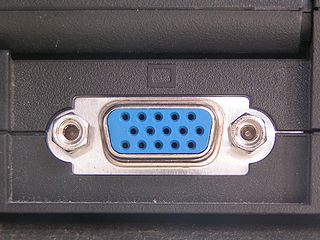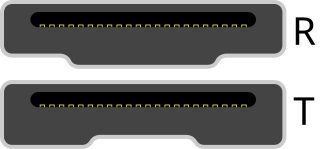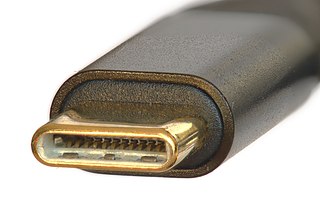
Universal Serial Bus (USB) is an industry standard that allows data exchange and delivery of power between many types of electronics. It specifies its architecture, in particular its physical interface, and communication protocols for data transfer and power delivery to and from hosts, such as personal computers, to and from peripheral devices, e.g. displays, keyboards, and mass storage devices, and to and from intermediate hubs, which multiply the number of a host's ports.

Digital Visual Interface (DVI) is a video display interface developed by the Digital Display Working Group (DDWG). The digital interface is used to connect a video source, such as a video display controller, to a display device, such as a computer monitor. It was developed with the intention of creating an industry standard for the transfer of uncompressed digital video content.

SATA is a computer bus interface that connects host bus adapters to mass storage devices such as hard disk drives, optical drives, and solid-state drives. Serial ATA succeeded the earlier Parallel ATA (PATA) standard to become the predominant interface for storage devices.

High-Definition Multimedia Interface (HDMI) is a proprietary audio/video interface for transmitting uncompressed video data and compressed or uncompressed digital audio data from an HDMI-compliant source device, such as a display controller, to a compatible computer monitor, video projector, digital television, or digital audio device. HDMI is a digital replacement for analog video standards.

The Video Graphics Array (VGA) connector is a standard connector used for computer video output. Originating with the 1987 IBM PS/2 and its VGA graphics system, the 15-pin connector went on to become ubiquitous on PCs, as well as many monitors, projectors and high-definition television sets.

DisplayPort (DP) is a proprietary digital display interface developed by a consortium of PC and chip manufacturers and standardized by the Video Electronics Standards Association (VESA). It is primarily used to connect a video source to a display device such as a computer monitor. It can also carry audio, USB, and other forms of data.

Unified Display Interface (UDI) was a digital video interface specification released in 2006 which was based on Digital Visual Interface (DVI). It was intended to be a lower cost implementation while providing compatibility with existing High-Definition Multimedia Interface (HDMI) and DVI displays. Unlike HDMI, which is aimed at high-definition multimedia consumer electronics devices such as television monitors and DVD players, UDI was specifically targeted towards computer monitor and video card manufacturers and did not support the transfer of audio data. A contemporary rival standard, DisplayPort, gained significant industry support starting in 2007 and the UDI specification was abandoned shortly thereafter without having released any products.
WirelessHD, also known as UltraGig, is a proprietary standard owned by Silicon Image for wireless transmission of high-definition video content for consumer electronics products. The consortium currently has over 40 adopters; key members behind the specification include Broadcom, Intel, LG, Panasonic, NEC, Samsung, SiBEAM, Sony, Philips and Toshiba. The founders intend the technology to be used for Consumer Electronic devices, PCs, and portable devices.

Universal Serial Bus 3.0, marketed as SuperSpeed USB, is the third major version of the Universal Serial Bus (USB) standard for interfacing computers and electronic devices. It was released in November 2008. The USB 3.0 specification defined a new architecture and protocol, named SuperSpeed, which included a new lane for a new signal coding scheme providing full-duplex data transfers that physically required five additional wires and pins, while preserving the USB 2.0 architecture and protocols and therefore keeping the original four pins and wires for the USB 2.0 backward-compatibility, resulting in nine wires in total and nine or ten pins at connector interfaces. The new transfer rate, marketed as SuperSpeed USB (SS), can transfer signals at up to 5 Gbit/s with nominal data rate of 500 MB/s after encoding overhead, which is about 10 times faster than High-Speed. USB 3.0 Type-A and B connectors are usually blue, to distinguish them from USB 2.0 connectors, as recommended by the specification. and by the initials SS.

PDMI is an interconnection standard for portable media players. It has been developed by CEA as ANSI/CEA-2017-A standard Common Interconnection for Portable Media Players in February 2010. Chaired by David McLauchlan from Microsoft, the standard was developed with the input or support of over fifty consumer electronics companies worldwide.

The Mini DisplayPort is a miniaturized version of the DisplayPort audio-visual digital interface.
Audio connectors and video connectors are electrical or optical connectors for carrying audio or video signals. Audio interfaces or video interfaces define physical parameters and interpretation of signals. For digital audio and digital video, this can be thought of as defining the physical layer, data link layer, and most or all of the application layer. For analog audio and analog video these functions are all represented in a single signal specification like NTSC or the direct speaker-driving signal of analog audio.
Thunderbolt is the brand name of a hardware interface for the connection of external peripherals to a computer. It was developed by Intel in collaboration with Apple. It was initially marketed under the name Light Peak, and first sold as part of an end-user product on 24 February 2011.

HDBaseT is a consumer electronic (CE) and commercial connectivity standard for transmission of uncompressed ultra-high-definition video, digital audio, DC power, Ethernet, USB 2.0, and other control communication over a single category cable up to 100 m (328 ft) in length, terminated using the same 8P8C modular connectors as used in Ethernet networks. HDBaseT technology is promoted and advanced by the HDBaseT Alliance.
V-by-One HS is an electrical digital signaling standard that can run at faster speeds over inexpensive twisted-pair copper cables than Low-voltage differential signaling, or LVDS. It was originally developed by THine Electronics, Inc. in 2007 for high-definition televisions but since 2010 V-by-One HS has been widely adopted in various markets such as document processing, automotive infotainment systems, industrial cameras and machine vision, robotics and amusement equipments.

USB-C, or USB Type-C, is a 24-pin connector that supersedes previous USB connectors and can carry audio, video and other data, e.g., to drive multiple displays or to store a backup to an external drive. It can also provide and receive power, such as powering a laptop or a mobile phone. It is applied not only by USB technology, but also by other protocols, including Thunderbolt, PCIe, HDMI, DisplayPort, and others. It is extensible to support future standards.

AMD Eyefinity is a brand name for AMD video card products that support multi-monitor setups by integrating multiple display controllers on one GPU. AMD Eyefinity was introduced with the Radeon HD 5000 series "Evergreen" in September 2009 and has been available on APUs and professional-grade graphics cards branded AMD FirePro as well.
The initial versions of the USB standard specified connectors that were easy to use and that would have acceptable life spans; revisions of the standard added smaller connectors useful for compact portable devices. Higher-speed development of the USB standard gave rise to another family of connectors to permit additional data paths. All versions of USB specify cable properties; version 3.x cables include additional data paths. The USB standard included power supply to peripheral devices; modern versions of the standard extend the power delivery limits for battery charging and devices requiring up to 240 watts. USB has been selected as the standard charging format for many mobile phones, reducing the proliferation of proprietary chargers.
VirtualLink was a proposed USB-C Alternate Mode that was historically intended to allow the power, video, and data required to power virtual reality headsets to be delivered over a single USB-C cable instead of a set of three different cables as it was in older headsets. The standard was supported by Nvidia, AMD, HTC Vive, Oculus VR, Valve, and Microsoft. The VirtualLink Consortium was chaired by Rambo Jacoby representing Nvidia. VirtualLink never launched successfully.

Universal Serial Bus 4, marketed as USB4 and sometimes referred to as USB 4.0, is a new technical specification of the Universal Serial Bus data connection standard, released on 29 August 2019 by the USB Implementers Forum.
















